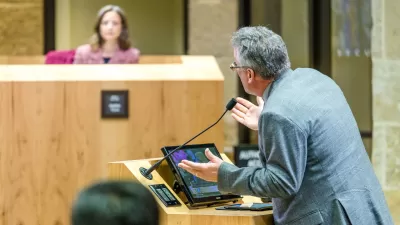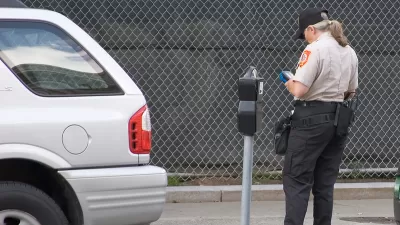A new book explains why people object to new housing in their neighborhoods, and whether these "neighborhood defenders" are representative of the public as a whole.

Not long ago, I read an interesting new book on zoning policy: Neighborhood Defenders, by three political scientists at Boston University. As the title indicates, the book focuses on people who try to limit new development in their neighborhood; although I and many others have often used the term “NIMBY” (Not In My Back Yard) to describe them, the authors suggest that the term “neighborhood defenders” more accurately describes what opponents of housing think they are doing—defending their neighborhood from unwelcome development.
These neighborhood defenders are able to exclude housing because of the public process surrounding zoning. Because zoning laws are so complicated, new building often requires a zoning change, which under current law nearly always requires a public hearing. Neighborhood defenders flock to these hearings and fight the project. Even if a city council is pro-housing, lawsuits or the threat of lawsuits can slow development down. For example, the authors show that a high number of zoning-related lawsuits correlates with a lower share of permits in multifamily buildings.
Based on a survey of dozens of towns in metropolitan Boston, the authors show that the number of zoning regulations is correlated with low levels of housing production, especially low levels of multifamily housing production. Suburbs with many different types of regulation have fewer new apartments or condos, and the buildings that are developed in these suburbs have fewer units. This correlation is not limited to regulations directly limited to housing supply (such as density limits); even more seemingly innocuous regulations can be used to delay housing. In other words, more regulation means less new housing.
Conventional economic wisdom suggests that neighborhood defenders are motivated primarily by a desire to protect their property values by limiting new housing. On the other hand, some new urbanists would like to believe that prettier projects would be more popular. The authors went through meeting minutes in Massachusetts towns, and discovered that neighborhood defenders are more likely to raise concerns about traffic and environmental concerns than either aesthetic or economic concerns. Less than 10 percent of commenters in the authors' sample directly mentioned aesthetic concerns, and even fewer mentioned home values. This may mean that neighborhood defenders really believe that new development is bad because it brings traffic and environmental degradation—or that they are sophisticated enough to know that complaining about ugly apartments or property values might not be as persuasive as traffic-related and environmental arguments.
The traditional justification for public meetings about zoning is that commenters represent the public. The authors disprove this idea: commenters at zoning meetings are much more likely to be homeowners as opposed to renters, and are whiter, older and more male. In the towns surveyed, 73 percent of commenters were homeowners, as opposed to 46 percent of all voters. Only 5 percent of commenters were nonwhite, as opposed to 13 percent of all voters. Nonwhites were generally more pro-housing than whites; just under 15 percent of white commenters supported new housing, as opposed to 45 percent of blacks. On the other hand, the sample of black commenters was so small (only 60) that I am not sure this fact is statistically significant. Hispanic commenters were even more anti-housing than whites—but here too, the sample size (29 commenters) seems too small to be probative.
The authors suggest that the opinions of neighborhood defenders are not representative of the public as a whole. They rely on the results of a 2010 referendum in Massachusetts on repealing Ch. 40B. Most voters voted no—that is, they supported affordable housing. By contrast, only 15 percent of commenters spoke in support of new housing at zoning hearings. On the other hand, it could be argued that voters were happy to support new housing as long as it was likely to be in someone else’s neighborhood, or that they preferred low-income housing to market-rate housing.
Thus, zoning creates a collective action problem: what might be good for each individual neighborhood (preventing new housing) is bad for the city or region as a whole. To solve this problem, the authors favor citywide and statewide zoning reforms, as well as more federal support for low-income housing.

Study: Maui’s Plan to Convert Vacation Rentals to Long-Term Housing Could Cause Nearly $1 Billion Economic Loss
The plan would reduce visitor accommodation by 25,% resulting in 1,900 jobs lost.

North Texas Transit Leaders Tout Benefits of TOD for Growing Region
At a summit focused on transit-oriented development, policymakers discussed how North Texas’ expanded light rail system can serve as a tool for economic growth.

Using Old Oil and Gas Wells for Green Energy Storage
Penn State researchers have found that repurposing abandoned oil and gas wells for geothermal-assisted compressed-air energy storage can boost efficiency, reduce environmental risks, and support clean energy and job transitions.

Santa Barbara Could Build Housing on County Land
County supervisors moved forward a proposal to build workforce housing on two county-owned parcels.

San Mateo Formally Opposes Freeway Project
The city council will send a letter to Caltrans urging the agency to reconsider a plan to expand the 101 through the city of San Mateo.

A Bronx Community Fights to Have its Voice Heard
After organizing and giving input for decades, the community around the Kingsbridge Armory might actually see it redeveloped — and they want to continue to have a say in how it goes.
Urban Design for Planners 1: Software Tools
This six-course series explores essential urban design concepts using open source software and equips planners with the tools they need to participate fully in the urban design process.
Planning for Universal Design
Learn the tools for implementing Universal Design in planning regulations.
Ascent Environmental
Borough of Carlisle
Institute for Housing and Urban Development Studies (IHS)
City of Grandview
Harvard GSD Executive Education
Toledo-Lucas County Plan Commissions
Salt Lake City
NYU Wagner Graduate School of Public Service






























